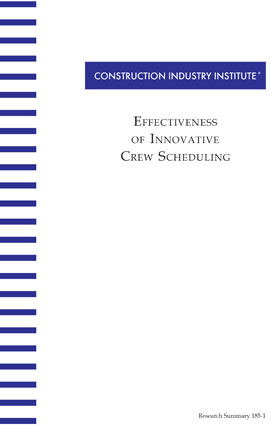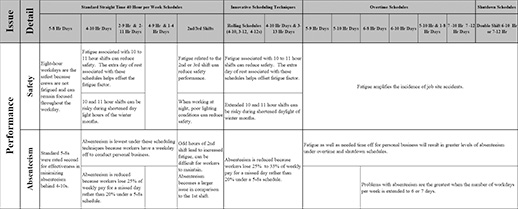
Effectiveness of Innovative Crew Scheduling
Several crew schedule options are available to owners and contractors when they select schedules for a project or when they find it necessary to compress or to accelerate a schedule. Techniques such as overtime, shift work, rolling or straight four-ten hour days, and other innovative schedules all have their own set of unique benefits and requirements for proper application.
Many studies have been funded on the impact of scheduled overtime on labor productivity. Information on innovative scheduling techniques (shift work, rolling or straight 4-10s, staggered 7-10 hour days, and others), however, is limited regarding its impact on safety, productivity, project duration, or cost. CII, therefore, established a project team to research innovative scheduling techniques. The objective of the study was to uncover best practices about when to apply them, conditions for their successful application, and the cost implications (including labor productivity losses and safety concerns) when using them.
The project team focused its efforts on determining if such schedules could provide sound choices for contractors and owners when planning their projects. The team gathered data from a sizable number of projects and found both “good and bad news.” The bad news was that not much is being done in the way of truly innovative schedule techniques; in fact, most supervisors and crews prefer the five day, eight hours a day traditional schedule. The good news was that during the research the team was able to collect an impressive amount of productivity data and then developed a predictive productivity model that can be of benefit in selecting schedules industry-wide. The project team’s work, including development of the predictive productivity model, is presented in summary fashion in this publication.
The project team also created an implementation tool (CII Implementation Resource 185-2) that is a summary of the information collected and is organized in tabular form (referred to as a “look up table”). The table compares each crew scheduling technique, the project characteristics, and the issues that may be impacted by the use of different crew schedules. The tool is intended to aid construction professionals in the selection of a crew scheduling technique that will meet the requirements of a specific project. After reading this research summary, readers should obtain the implementation resource from the CII website and use it to improve project planning.
Safety
- Both agree 5-8s only schedule with positive impact on safety.
Productivity
- Both agree 5-8s best for productivity.
- Unions rate 4-10s very high positive impact.
Cost
- General agreement 5-8s and 4-10s have positive impact.
- Contractors rate 5-8s most positive impact.
- Unions rate 4-10s slightly higher positive impact.
Duration
- General agreement all schedules have positive impact except 3rd shift.
- Both stated overtime had most positive impact.
Absenteeism
- Both felt 4-10 had most positive impact.
- Contractors had 5-8 slightly positive impact; all others negative impact.
- Union had 5-8 slightly positive impact; all others almost no impact.


